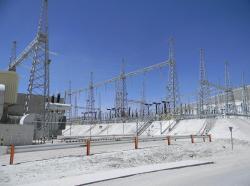
SING electricity generation during 2012 increases to its highest level in eight years.
The increase in demand is linked to the incorporation of new mining projects in the pipeline.
Source / María Marañón, Diario Financiero
http://www.df.cl/generacion-electrica-del-sing-durante-2012-aumenta-a-su-mayor-nivel-en-ocho-anos/prontus_df/2013-04-07/200749.html
Electricity generation in the Norte Grande Interconnected System (SING) recorded a significant increase in 2012, making it the largest increase in the last eight years.
According to the specialized consulting firm Systep, the 5.5% increase in generation, only surpassed by the 7.9% recorded in 2004, is explained by the growth in energy demand, especially for mining projects.
Looking ahead over the next ten years, GWh sales are expected to continue to rise, to 28,895 GWh in 2022. The largest annual increase would be observed in 2014 with a forecast increase in demand of 8.1%, as detailed in a preliminary report by the National Energy Commission.
This increase is closely related to the mining projects in the pipeline, according to the consulting firm.
According to figures from the Chilean Copper Commission (Cochilco), US$ 104.3 billion will be invested between 2012 and 2016, of which 77%, or US$ 80.409 billion, will go to copper mining, although there has also been a notable increase in gold mining.
The gap between the main generators is narrowing
To meet the needs of the copper industry, the companies that sell energy to the system generated 16,755 GWh last year, with AES Gener being the main producer. However, although the company continues to maintain its leadership, the generation gap with its main competitor, GDF Suez, has narrowed in recent years.
Thus, in 2006, Gener had a 30% share of total generation (its highest share of the decade) compared to 15% for the Franco-Belgian company, a gap that narrowed to 33% of the total compared to 29%, respectively. Endesa has also reduced its generation supply from 17% in 2003 to 7% in 2012.
The phenomenon is justified by the increase of new participants in generation, which during the previous year represented 31% of total production, while adding 37% of installed capacity, which in general terms decreased with respect to 2011 as a consequence of the fact that the Salta plant, owned by AES Gener and located in Argentina, was eliminated from the 2012 statistics.
To pre-gas dispute levels
It is important to remember that in recent years there was an over-installation of capacity to supply demand as a result of several natural gas plants in the SING that were built to accommodate gas shipments from Argentina, and which could not be used at full capacity after Néstor Kirchner’s government applied supply restrictions in 2004.
Thus, before these limitations were implemented, the ratio between installed capacity and maximum demand in the SING went from 1.44 (times) in 1998 to 2.81 in 2001, a figure that in recent years has approached normal utilization levels with the entry of new coal-fired capacity, according to Systep.
SIC: Colbún overtakes Aes Gener and returns to second place in generation
The presence of other participants strongly increases capacity.
In the last 10 years, the installed capacity of the Central Interconnected System (SIC) has almost doubled, from 6,996 MW in 2003 to more than 13,739 MW last year, when capacity grew to its highest level since 2009. According to data from this period, the participation of the main companies that make up the energy matrix has been changing.
Although Endesa maintains its leadership in generation with 39% of the total, there is evidence of a drop in its prominence when observing that in 2003 it had 47% of the total generated in the SIC. “In view of the fact that Endesa has a significant installed capacity in hydroelectric and reservoir power plants, the drought conditions observed in recent years have resulted in a decrease in hydroelectric generation, in addition to which the new capacity that has entered the system is mainly thermal,” says the consulting firm Systep.
The evolution of Colbún and Aes Gener is also interesting, since the company controlled by the Matte group managed to regain second place in generation after it was taken from it in 2010 by Gener. Thus Colbún, which remains stable both in installed capacity and in its share of generation (22% of the SIC total), is almost tied with Aes Gener, which now occupies 20% of the latter, a share that increased due to the greater use of thermoelectricity observed in recent years.
The increase in installed capacity in recent years is due to the entry of the Santa Lidia and Nueva Ventanas thermoelectric plants, Guacolda units 3 and 4, and the Campiche plant (270 MW of gross capacity), which came into operation this year. In sum, the three large companies accounted for 82% of the SIC’s generation share in 2012, compared to 18% for other companies, a situation that has remained stable over the last decade, although they have gained space in terms of installed capacity, accounting for 27% of the total, compared to 14% in 2003. Thus, despite this greater incursion, the supremacy of the big three firms continues.



